![]()
contributed by Beth Cowan [architect / avid blogger / continent hopper]
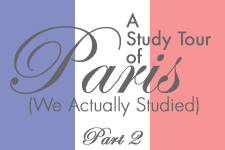 [NOTE: If you haven’t read Part 1, then this month’s tour tales will probably cause you to be more confused than Catherine Deneuve in a Wal-Mart Supercenter.] From there we went to Parc Citroën, which is, as you might, imagine, associated with the carmaker. I believe the area was a car factory and then a munitions factory during WWII, and then abandoned for many years only to be re-adapted as a park in the 90s. This one I studied in graduate school and was quite excited to see what the hell my professor was so inarticulately trying to describe to us.
[NOTE: If you haven’t read Part 1, then this month’s tour tales will probably cause you to be more confused than Catherine Deneuve in a Wal-Mart Supercenter.] From there we went to Parc Citroën, which is, as you might, imagine, associated with the carmaker. I believe the area was a car factory and then a munitions factory during WWII, and then abandoned for many years only to be re-adapted as a park in the 90s. This one I studied in graduate school and was quite excited to see what the hell my professor was so inarticulately trying to describe to us.
Up, Up & Away
The only things I remembered from what he was telling us were the following items: palm trees, black stone, water and trees. It’s an interesting materials list. It was an interesting park. I now understand what he was talking about and will be inarticulately trying to describe it myself in the future. It’s a very modern park – designer park if you like – and it really is best seen in plan to understand how the elements relate to one another, especially the diagonal slash through the entire park. Luckily, there is a hot air balloon in the park that rises 150 meters in the air for some amount of time to do just that.
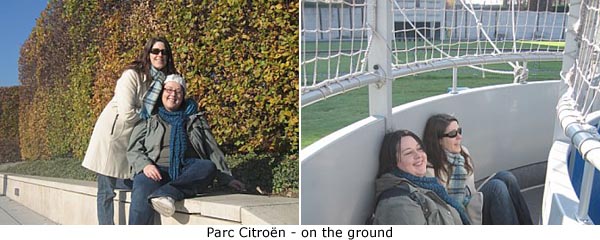 For the bargain price of 12 euro a person, the viewer is treated to stunning views of the city of Paris and the park below. I can only assume this, however. It is difficult to see stunning views of Parc Citroën from the floor of a hot air balloon and that is where I spent my time, trying not to burst into tears as the floor tipped and swayed and creaked. I have vertigo and a well-developed fear of heights. I shouldn’t have gone but since the entire office was participating, it was reasoned that I should join as well. Democracy always works against me.
For the bargain price of 12 euro a person, the viewer is treated to stunning views of the city of Paris and the park below. I can only assume this, however. It is difficult to see stunning views of Parc Citroën from the floor of a hot air balloon and that is where I spent my time, trying not to burst into tears as the floor tipped and swayed and creaked. I have vertigo and a well-developed fear of heights. I shouldn’t have gone but since the entire office was participating, it was reasoned that I should join as well. Democracy always works against me.
Parc Place
Back to the park. It is divided into our parts: manicured lawn, greenhouses surrounded by fountains, six stylized gardens and one traditional park. I’d say Alberti’s 7 Rules for the Garden are met in some form or other, but to the casual observer, they left out a few. Although we have water in the garden in the form of the water jets, a lengthy canal, and a reflecting pool, it is far from being reminiscent of a stream in nature, which Pliny considered ideal.
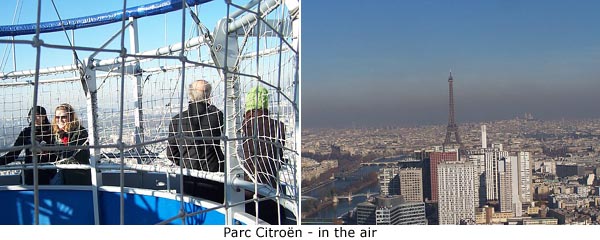 We have greenhouses masquerading as casinos but no real parterre to surround them. There are no grottoes or boscoes to speak of, although there is a path through some low trees that could get quite treacherous if left to overgrow. Perhaps it is more French garden than Italian Renaissance. It is, however a nice park to spend the day in, provided the day is warm and there is no balloon activity.
We have greenhouses masquerading as casinos but no real parterre to surround them. There are no grottoes or boscoes to speak of, although there is a path through some low trees that could get quite treacherous if left to overgrow. Perhaps it is more French garden than Italian Renaissance. It is, however a nice park to spend the day in, provided the day is warm and there is no balloon activity.
Museum Marvel
From there we loaded up and drove through the streets to our last visit for the day, the new Jean Nouvel museum, Musée du Quai Branly. On my last trip to Paris, only the administration building was finished and while the intent was obvious, the plantings hadn’t quite taken root, so the building was a bit weedy. The façade of the building is essentially a garden, planted with native species, irrigated and tilted to the vertical rather than the traditional horizontal we mere mortals are familiar with. Garden as building. I was quite excited to see how it looked two years later. It was amazing and shocking and beautiful. Which sort of describes most of his projects.
The final part of the museum has been built, and the entire complex is now open. It is a complete departure from the administration building. Then again, the entire complex is a collision of ideas and identities, none of which seem to lead the charge. The main galleries are one story in the air, stretching the length of the site, expressed with boxes of various sizes, overhangs, and colors, all tied together with canted glazing. The administration building opens in the back to connect with a multi-story glass building with timber and metal louvers, all a very green building ethos.
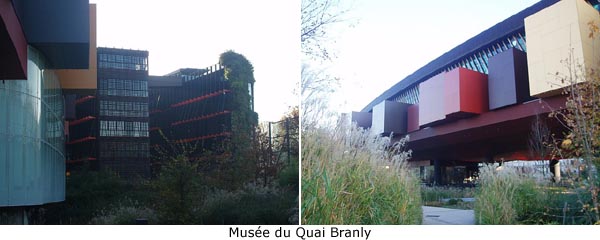 The main entry is quite exciting looking with two-story walls of glass in various states of opacity and signage in various languages, but again, it bears little relationship to what is beyond. It would appear the main purpose of this wall is to dampen the noise from the very busy road it fronts, but sadly, it also cuts off the viewer from the Seine, which is across the very busy road.
The main entry is quite exciting looking with two-story walls of glass in various states of opacity and signage in various languages, but again, it bears little relationship to what is beyond. It would appear the main purpose of this wall is to dampen the noise from the very busy road it fronts, but sadly, it also cuts off the viewer from the Seine, which is across the very busy road.
The landscaping is beautiful. The undercroft is impressive. The museum is indeed impressive but it left me confused as to its identity. It does, however, lend itself to loads of very sexy photographs, including an amazing shot of the Eiffel Tower. We admired the grounds, got in trouble for smoking near the plants, and then jumped into the mini-van before it was ticketed for double parking.
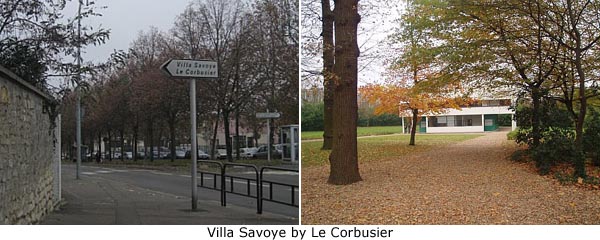 Savoye-Faire
Savoye-Faire
The next morning, we drove to Poissy, which is a town outside of Paris notable for only one thing: Villa Savoye, my second Corb house and definitively The Icon of the Modern Movement. Not really looking forward to it after my first brush with Corb, especially since it was bitterly cold and foggy, but it was instantly better upon arrival. Perhaps the celebrity of the project had something to do with it – I don’t know. But crunching up the drive, I was excited to see it.
Two things I did not remember about the project: There is a guardhouse/garage at the entry and the front door is at the back of the site. I find that odd, so it makes me wonder if I ever realized the front door is in the back. Who walks the entire way round their house to enter it” Also, it hadn’t occurred to me there was no sidewalk.
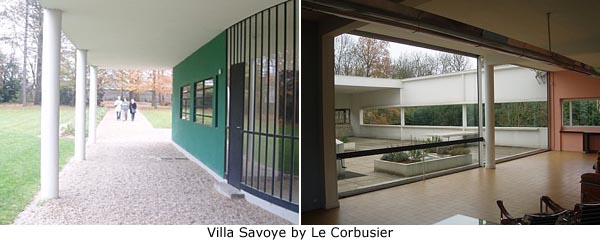 The Savoye family was a very wealthy family who were driven to their country home by their chauffeur who would drive under the overhang, round to the front door, drop the family, and then proceed back to the gatehouse. It was never intended for any other purpose than to have rich people dropped at the door. I am not rich and so would not have gleaned this fact had the docent not explained it to us on our tour.
The Savoye family was a very wealthy family who were driven to their country home by their chauffeur who would drive under the overhang, round to the front door, drop the family, and then proceed back to the gatehouse. It was never intended for any other purpose than to have rich people dropped at the door. I am not rich and so would not have gleaned this fact had the docent not explained it to us on our tour.
She was helpful, despite only speaking French. Jeanne reluctantly translated, since the transit strike kept our promised English speaking docent in Paris. It was a great tour in which she explained a lot that I did not know about the house. Or perhaps I’d known at one point in architecture school but forgot in all the sleep deprivation. Worth the money we paid for the tour.
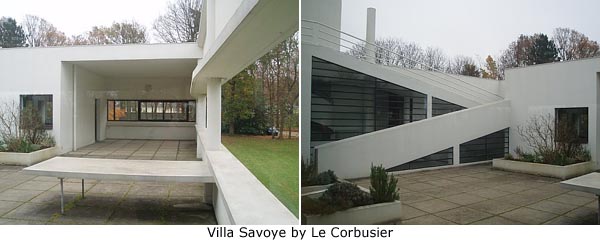 Fun House
Fun House
My biggest discovery here was the fact that the Americans saved the day. After WWII the building was abandoned and slated for demolition until an American stepped in, bought the property and surrounding lands, and dedicated himself to renovating what was then deemed as the most important piece of architectural history in the world.
I also discovered that I much prefer Late Corb to Early Corb. The ramps were, yet again, far too steep for modern use but the detailing, while simplistic, was far better than at La Roche. The spaces were also much better, both in height and usability. I found the innovativeness of the features to be exciting: the very large sliding glass doors in the living room, the living room light fixture, and cabinetry to define spaces rather than walls.
I particularly loved the bathroom in the guest bedroom, which is not a room but less than ceiling-height walls that hide the function, create a closet, and give the bed a proper space facing the ribbon windows. Villa Savoy is Corb taking advantage of planes to define or blur spaces. It becomes a game, which is quite fun in this house.
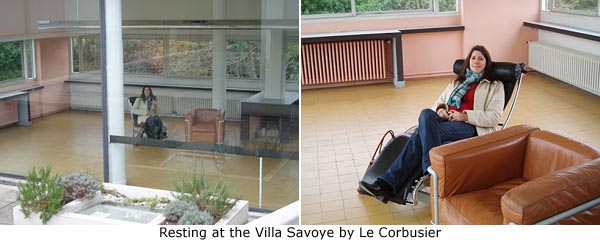 Au plaisir de vous revoir!
Au plaisir de vous revoir!
From there we drove back into Paris to see our last project: Bibliothèque Nationale de France by Dominique Perrault. I slept all the way until the chauffeur got on the microphone to serenade us with an Yves Montand tune. Karaoke and unlimited Kleenex supplies – he was a bargain, that man. The fact that he didn’t know his way around Paris was trifling really.
The group then asked me to sing some Sinatra for them to which I replied, rather politely: “No way in hell.” I went back to sleep. When we got to the library, I remember the daylight was golden, the bridge was interesting and the towers were large. I took some photos and then went inside to sleep in a chair in the hall. Not the best trip to the library for me admittedly.
Back at the hotel, we packed and went for one last lunch before the group went back to the airport. It was a sad ride through the streets of Paris, seeing all the cute restaurants and shops we wouldn’t be in, the nice bars yet unexplored. Sick as I was and tired of the cold air in my lungs, passing by Père-Lachaise cemetery made my heart sink. I am more charmed by Paris each visit. Going back to Dublin has never been so sad.


